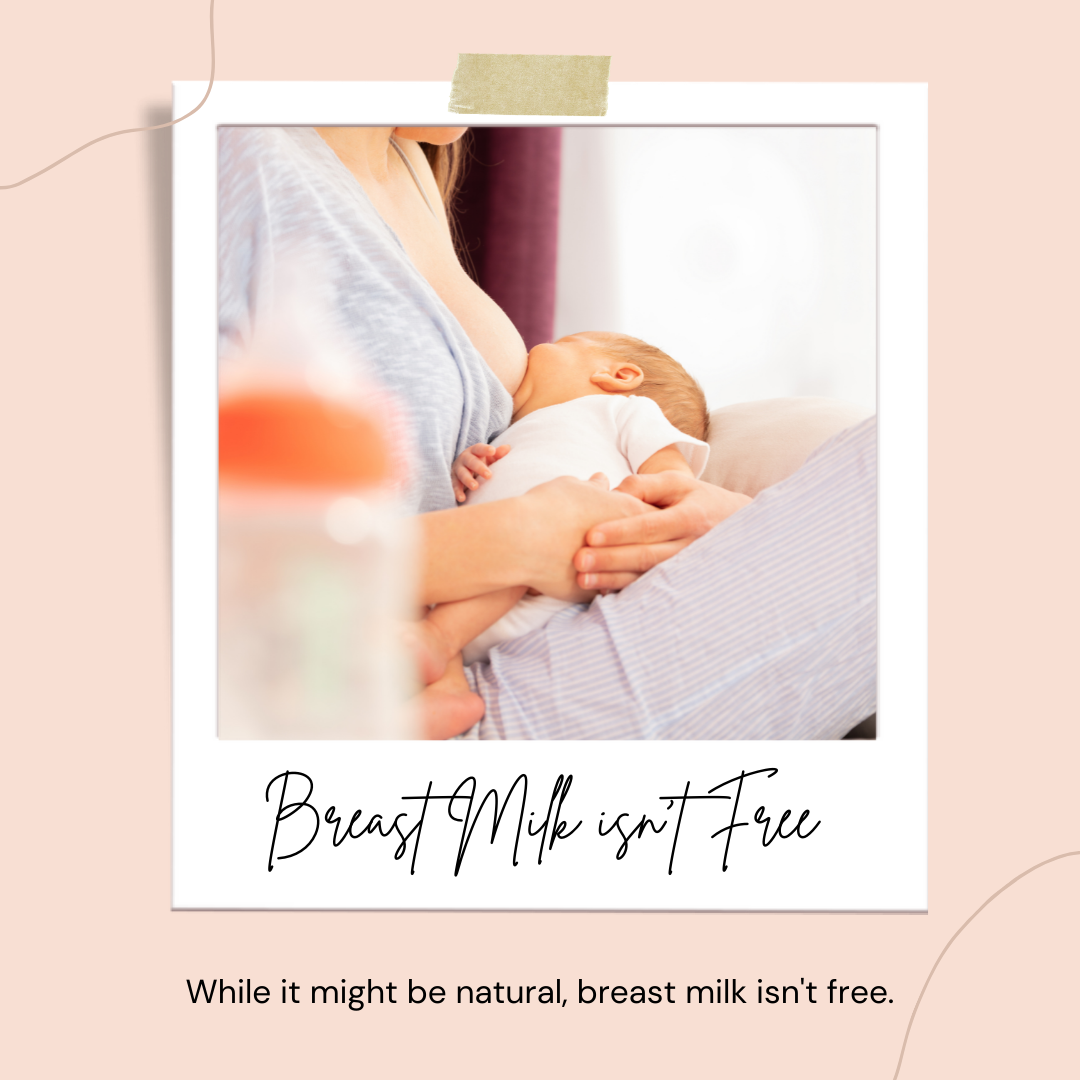The Cost of Breastfeeding
Mommy Care Team
Shedding Light on the Hidden Costs of Breast Milk
As a naturally produced substance from a mother’s body, many people mistakenly assume that breast milk is free. Breast milk is commonly referred to as liquid gold. And while we’d like to think of all moms as magical milk making creatures, we can’t make milk from straw like Rumpelstiltskin. As part of our effort to normalize breastfeeding, we need to shed light on its hidden costs.
If you’re a mom, you know it’s not as simple as putting your baby to the breast, as it is so commonly portrayed. And beyond the production of liquid gold, getting it into our babies tummies is a whole other bag of tricks. Breastfeeding, whether nursing or pumping, takes time, effort, and there’s an emotional aspect to it as well.
Some days you and your baby are soaring and other days you just can’t seem to make it work. If parenting is a roller coaster, breastfeeding is the part where you hit the double dips and rocket straight into a loop. Moms work round the clock to feed a baby, including in the isolating dark hours during the night. And it takes a toll.

The Hidden Cost of Nursing
Nutrition for Mom:
For moms, the saying “you are what you eat” goes double for breastfeeding moms. You are your baby’s primary source of nutrition. That’s powerful, and also for some, daunting. Our grocery bills are one part of our budget, but often breastfeeding moms benefit from continuing to take their prenatal vitamins, or other supplements to ensure both they and their baby get optimum nutrition.
Breastfeeding Pillow:
While you could go without a breastfeeding pillow, they do make things a lot easier. Especially in the early days when we exist in the fog of recovery and are just getting to know our new baby, having a support can make breastfeeding more comfortable and safer. Many moms recommend adding this type of support to your baby registry.
Water Bottle
When it comes to breastfeeding, hydration is the name of the game. Investing in a good water bottle (or a few) can help make staying hydrated easier. Keeping water with you throughout the day means never falling into a deficit.
Snacks:
Breastfeeding burns calories. Moms who are feeding their babies will most likely need additional snacks. Invest in healthy snacks that you can keep in your purse or diaper bag, breastfeeding station, and in the car.
Pumping Station or Caddy:
While we’re making a list of all of the extra things you’ll need as a breastfeeding mom, most moms don’t like to see these strewn haphazardly around the house. It helps to invest in a caddy, shelving unit, or additional storage to house these extra items.
Nursing Clothing:
Even our clothing shifts when breastfeeding. Nursing bras, camis, and other clothing make it easier to nurse on demand. They also help moms stay healthy. Restrictive clothing can lead to clogs which when left unchecked can turn into mastitis.

Nursing Pads and Burp Cloths:
A fact of breastfeeding is a bit of a mess. Moms might experience leaking both during the day and night. Reusable nursing pads can help moms from having to do extra laundry, or pack a change of clothes. This can be especially helpful for a mom returning to the workforce.
Burp cloths help take care of any mess at the time of feeding. Sleepy babies might dribble a bit. There might even be some spit up. So having a cloth on hand to protect your clothing and wipe up any mess is a plus. Burp cloths can also make burping safer or more comfortable for your baby depending on what you are wearing.
Comfy Chair:
When you’re up at three AM feeding your baby in the middle of the night, a comfortable chair, rocker, or glider makes all of the difference. Many moms invest in a rocker or glider, or a comfy arm chair to provide comfort and support whether you are nursing or pumping.
Time:
One of the most invisible costs of breastfeeding is the time it takes. Nursing and pumping can take us away from other children, our partners, away from social gatherings. It also takes time away from our sleep, sapping much needed energy.
Emotions:
We want to think that breastfeeding will be easy for every mom. The unfortunate truth is that, there will, for most, be bumps in the road. These bumps are often accompanied by emotions. When we have difficulty feeding our babies, we can feel failure. When our journey ends, we can feel like we let them down. Worry, doubt, and sometimes even panic can set in. When we decide to wean our babies, there can be another host of emotions here as well.
Energy:
It is the greatest gift that we can give to our children at the start of their brand new lives, but it does take its toll. Making milk takes energy and nutrients from our bodies. Being up at night feeding our babies robs us of our own sleep. Breastfeeding takes a lot from us that we often do not think about.

The Hidden Costs of Pumping:
While biological nursing has its own costs, pumping takes it to the next level. Yes, pumping moms have all of the costs that we’ve outlined so far and then some. The following are additional costs for moms who pump whether that is exclusively, to supplement for childcare, or here and there to maintain their supply.
Pump:
More and more it seems like the major insurance plans are covering some sort of pump, but it’s still not guaranteed. Before you deliver, it's a good idea to call your insurance provider to see if a pump is covered, familiarize yourself with that pump and brand, and when you are eligible to order the pump. Sometimes you need to wait until you actually have the baby to have your insurance cover the pump.
The newer wearables, or cordless options generally are not covered by insurance. A mother depending on her needs, or her lifestyle may opt to pay out of pocket in order to upgrade to one of these other options.
Bottles:
Pumps tend to come with a few storage bottles, and sometimes these bottles will double as feeding bottles as well. But there are often only one or two included. Moms who pump will generally need to invest in a larger quantity of bottles. This is because you’ll need two bottles for pumping (if you use an electric pump rather than a manual), and you’ll need a few extra for feeding your baby especially if you plan to return to work or use childcare.
Extra Flanges:
Like bottles, pumps tend to come with a few flanges. Often the major brands provide two sizes of flange. Before you use your pump, it’s important to determine the flange size that you need. Lactation professionals are a reliable source and can easily help you determine this measurement. You may need to order an additional flange or flanges in your size if they are not included with your pump.
Having a few extra flanges is also helpful. At some point you may need to replace your flange and having an extra on hand means you won’t have any missed pumps or downtime. This also makes the logistics of washing your pump parts easier. Having extra flanges means you don’t have to wash yours after every pump. This is a great tip for working moms.
Cushions:
Having the correct flange size helps to avoid pain, abrasion, and other forms of trauma to your nipples, but you can still make pumping more comfortable. If you add BeauGen’s patent pending cushions to your flange, you can achieve a better seal, and get a more comfortable pumping experience. You might also be able to find a more accurate fit depending on your measurements with the BeauGen cushions. These cushions should be replaced every 8 weeks at the minimum, sooner if you pump more frequently.

Replacement Parts:
Similarly to what we mentioned in regards to flanges, having extra pump parts on hand means you always have what you need. Parts will need to be replaced as they wear out, and extra parts also means you can put off washing your pump parts after every use.
Pump Bag:
Many pumps come with a bag, but depending on your pumping needs that one bag might not fit everything. Newer pump bags often come with a built-in cooler compartment for milk storage, have a place for your pump, and other compartments for everything else you might need including hands free pumping bras, flanges, etc. There are different pump bags for different budgets so make sure to look around and find one that is right for you.
Cooler for Transporting Milk:
If you don’t find a bag with a built-in cooler, having a small lunch box sized cooler is important for storing milk while you travel. If you are commuting back and forth to work, or pumping while running errands or chauffeuring your other children around this cooler will be very important.
Extra Freezer or Mini Fridge:
If you have a larger supply of milk, you might need additional space to store it. Many moms can get by with a few bags in their freezer, or the milk they store in the fridge. Other moms however may need to invest in a chest freezer or mini fridge to help keep their milk good. Some working moms invest in a mini fridge to keep in their offices. These can be passed on to other moms who need to pump after you are done with them.
Time and Wages:
We mentioned time in the breastfeeding section above, but it’s worth mentioning here again. While employers must give moms time to pump, they are not required to compensate moms for that time. So not only are these moms taking time out of their busy day to give their babies the best nutrition, they are also missing out on wages.
Emotions:
Grief can be an added side-effect of not being able to biologically nurse your baby. As mothers, we have this dream of nursing our babies. When that dream doesn’t pan out, it can cause unexpected emotions to well up. It’s important to remember that these emotions are natural, and valid. It’s tempting, but don’t push them away. If you are grieving for your nursing journey, consider talking to someone from a friend, a lactation professional, or probably the best equipped to help you, a therapist.

1 comment
This hits home on so such a raw level.